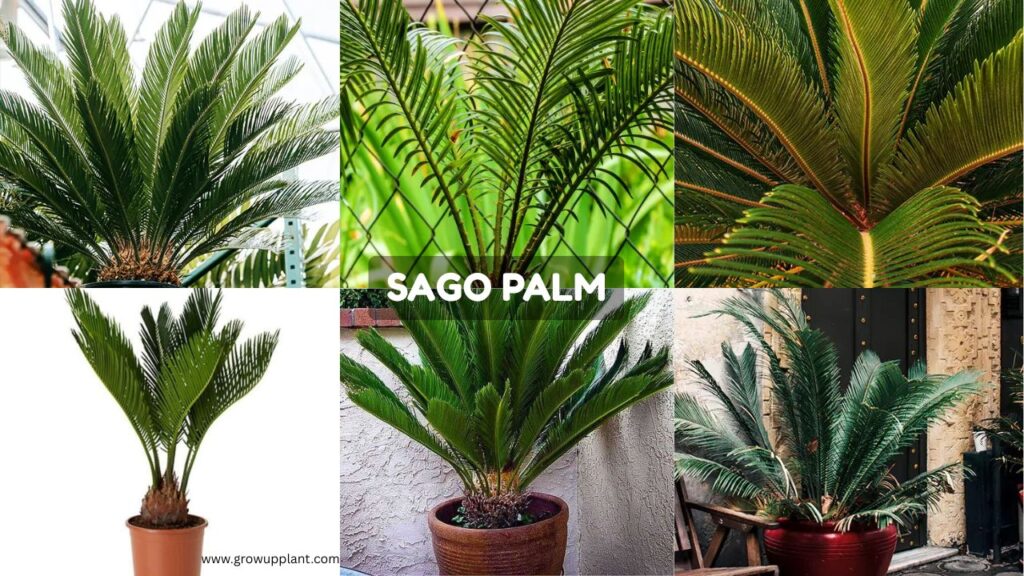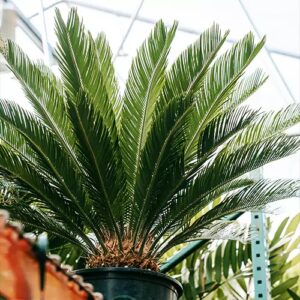How to Grow and Care for Sago Palm
The sago palm (Cycas revoluta) is a stunning, low-maintenance plant perfect for indoor and outdoor landscaping. Despite its name, it’s not a true palm but a cycad, known for its feathery, dark green fronds and symmetrical rosette shape. Native to southern Japan, the sago palm is drought-tolerant and thrives in bright, indirect light with well-drained soil. Ideal for tropical-themed gardens or as an elegant houseplant, it grows slowly and adds a dramatic, sculptural element to any space.
Gardeners love the sago palm for its resilience and minimal care needs. However, it’s important to note that all parts of the plant are highly toxic to pets and humans, especially the seeds, which can cause severe liver damage. For safe, stylish greenery, place sago palms out of reach of children and animals. Looking for a bold, exotic plant that’s easy to grow? The sago palm is a top choice for modern gardeners.
| Common Name | Sago palm |
| Scientific name | Cycas revoluta |
| Family | Cycadaceae |
| Native to | Southern Japan |
| Height | Typically 3–10 feet tall, but can get taller over many years |
| Sun Exposure | Full, partial |
| Hardiness Zones | 9–10 (USDA) |
| Toxicity | Toxic to humans and pets |
Read Also: How to Plant and Grow a Spider Plant at Home: Complete Guide 2025
Sago palm Plant Care
main care requirements for growing a sago palm:
- They can tolerate some direct sunlight—especially morning sun—but be cautious with harsh afternoon rays, which can scorch the fronds
- Soil pH should be acidic to neutral (5.5–7.0); acidic conditions enhance nutrient uptake, such as manganese
- Sago palms are drought-tolerant; water thoroughly only when the soil has dried out
- Best grown in 65–85 °F (18–29 °C); tolerate brief drops to 50°F but avoid frost below 23°F
- Standard feeding schedule: twice per growing season or monthly until late summer
- Avoid over-pruning to preserve nutrient flow; older fronds help feed the plant .
How to Plant Sago Palm
Planting a sago palm (Cycas revoluta) requires care and attention to ensure healthy growth. Start by choosing a location with bright, indirect sunlight or partial shade—especially important in hot climates. For containers, use a well-draining potting mix, such as a cactus or palm soil blend. Outdoors, ensure the soil is sandy or loamy with good drainage to prevent root rot.
Dig a hole twice as wide as the root ball and about the same depth. Gently remove the sago palm from its nursery pot, loosen the roots slightly, and place it in the hole. Fill in with soil, pressing lightly to remove air pockets. Avoid planting too deep—the top of the root ball should be level with the ground.
After planting, water thoroughly to settle the soil. Keep the soil slightly moist during the first few weeks to help establish roots, then reduce watering as the plant becomes more drought-tolerant. Avoid fertilizing until new growth appears, typically after a few weeks.
Watering
Sago palms are drought-tolerant; water thoroughly only when the soil has dried out. Water whenever the soil feels dry to the touch, making sure never to overwater to the point of soggy soil. Slightly reduce watering in the winter when the plant is not actively growing.
Light
Sago palms thrive in bright, indirect light—east- and west-facing windows are ideal.They can tolerate some direct sunlight—especially morning sun—but be cautious with harsh afternoon rays, which can scorch the fronds.In low-light indoor conditions, growth slows and the foliage may become sparse.For darker spaces, consider a grow light for 8–12 hours a day to promote healthy frond development
Soil
Sago palms prefer a light, well-draining potting mixture—such as cactus soil or sandy loam with peat moss or compost. Soil pH should be acidic to neutral (5.5–7.0); acidic conditions enhance nutrient uptake, such as manganese.
Temperature and Humidity
Best grown in 65–85 °F (18–29 °C); tolerate brief drops to 50°F but avoid frost below 23°F. Outdoors, protect the plant from frost—covering with burlap or moving indoors helps .Sago palms prefer moderate to high humidity. Mist occasionally, use a humidity tray, or group with other plants. Keep indoors away from drafty vents or windows to avoid sudden temperature fluctuations .
Fertilizer
Use a slow-release palm fertilizer or monthly liquid feed (NPK: 18–8–18 or 4–1–5) during the growth season. .Standard feeding schedule: twice per growing season or monthly until late summer . Avoid excessive nitrogen—can deform fronds; supplement magnesium/manganese when deficiency symptoms appear.Yellowing of new leaves (frizzle top) often signals manganese deficiency—treat with manganese sulfate once yearly. Ensure soil remains acidic for optimal nutrient absorption.
Pruning & Maintenance
Only remove fully brown or yellow fronds, ideally close to the trunk. Avoid over-pruning to preserve nutrient flow; older fronds help feed the plant. Common pests include scale insects, mealybugs, and spider mites. Treat with organic insecticidal soaps or neem oil; brush off scale manually . Severe infestations may require systemic insecticides like imidacloprid.
Type of Sago Palm
There is one primary species commonly referred to as the Sago Palm, but there are a few related species in the Cycas genus that are also sometimes called “sago palms.” Here’s a breakdown of the main types:
1.Cycas revoluta (King Sago Palm)
- Most common variety
- Native to Japan
- Features stiff, glossy, dark green fronds and a rugged, trunk-like base
- Grows slowly, typically up to 10 feet outdoors (3 feet indoors)
- Ideal for pots or landscape use
- Cycas rumphii (Queen Sago Palm)
- Similar appearance to Cycas revoluta but with softer, longer fronds
- Native to Southeast Asia
- Faster growing and taller (up to 15 feet)
- Less cold-tolerant, best for tropical climates
3. Cycas circinalis (Queen Sago or False Sago)
- Native to India and Sri Lanka
- Sometimes confused with Cycas rumphii
- Has arching fronds and is widely grown in tropical areas
4. Cycas taitungensis (Taiwan Sago Palm)
- Native to Taiwan
- Closely resembles Cycas revoluta but is slightly more cold-tolerant
- Rare and used mostly in specialty gardens or collections
Common Problems & Solutions
Yellow Leaves
- Overwatering, lack of nutrients, sun scorch, or temperature shock could be causes.
- Identify the issue—stop watering if root rot is suspected; adjust light or fertilization if deficiency is detected .
Root Rot
- Caused by soil staying too wet .
- Restore health by:
- Allowing soil to dry,
- Repotting in fresh, well-draining soil,
- Trimming diseased roots,
- Applying fungicide if needed.
- Allowing soil to dry,
Pest Infestation
- Look for insects, sticky residue, or sooty mold .
- Natural pest control methods work well; use horticultural oil or systemic products as required .
9. Propagation
Offsets (“Pups”)
- Remove pups—small offshoots at the plant’s base—in spring or autumn.
- Let the pup base be callous for a few days, then plant in a well-draining mix .
- Keep in bright, indirect light and water sparingly .
From Seed
- Sago palms are also grown from seeds, though slower and less commonly done.
- Seeds should be sourced reliably—remember all plant parts are toxic
Sago Palm FAQs
Q: How fast do sago palms grow?
A: Extremely slowly—typically producing only 1–2 new leaves per year.
Q: Can sago palms grow in full sun?
A: Yes, especially outdoor specimens can handle morning sun or dappled sunlight; avoid intense afternoon rays.
Q: What watering frequency is best?
A: Usually once every 1–2 weeks, but the soil dryness level is the real guide—only water when the top soil is dry.
Q: How do I correct yellow fronds?
A: First, identify the cause—manganese deficiency, overwatering, sun scorch, or cold—then adjust lighting, watering, or apply manganese sulfate accordingly.
Q: Is repotting necessary?
A: Only every few years—just select a larger pot and refresh soil; the plant prefers being slightly root-bound.
Conclusion
In conclusion, growing and caring for a sago palm is both rewarding and manageable with the right approach. These ancient, ornamental plants thrive in well-draining soil, bright indirect light, and moderate watering. Though slow-growing, sago palms are low-maintenance and long-lived, making them ideal for both indoor and outdoor spaces. Proper fertilization, occasional pruning, and pest prevention help maintain their striking appearance. However, caution is necessary due to their toxicity. With attention to their basic needs—light, water, soil, and temperature—your sago palm can become a beautiful, enduring centerpiece in any garden or home for many years to come.



